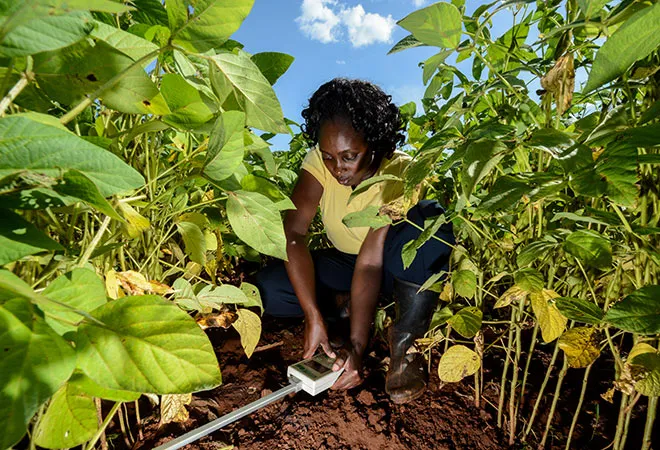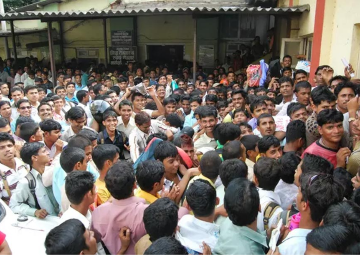
The world has come a long way towards ensuring food security. However, all the good work of the past has the potential to be unravelled due to the looming threat of climate change. The Sustainable Development Goals (SDGs) 1 & 2 envision a world with zero poverty and zero hunger. Food supply needs to grow by 60 per cent from 2006 levels by 2030 in order to satisfy the demand for food. In order to meet the projected demand for food, we would require higher yields, given that it may not be possible to raise acreage substantially.
However, according to the Intergovernmental Panel on Climate Change (IPCC), we could see crop yield declines of 10-25 per cent by 2050, which will have serious repercussions on global food availability. Undoubtedly, this will have an impact on global food availability. In the livestock sector, declines in productivity, yields of feed and forage crops and animal health will be compromised due to climate change. Prevalence of plant based, and animal based diseases are likely to shoot up as well. Ocean dependent communities will likely face instability in livelihoods. It has been estimated that rising temperatures will reduce catches of main fish species by 40 per cent by 2050.
Clearly, we are likely to face major disruptions in food supply – be it crops, meat or fish. This in turn is likely to affect the incomes of millions of small and marginal farmers across the world. The repercussions on the incomes of small and marginal farmers might even see an increase in poverty levels, with the Food and Agriculture Organisation (FAO) estimating that we may see more than 122 million people in extreme poverty due to the effects of climate change. India’s Economic Survey also reiterated this finding of falling farm incomes. This in turn will compromise food access, by lowering purchasing power of consumers. Concomitantly, we may also see a decline in nutritional outcomes, as access to food may be compromised. The effects of climate change will be felt both on the demand side and supply side. Therefore, urgent action is necessary now to prepare ourselves for the future.
So what exactly is climate smart agriculture (CSA)? Broadly speaking, CSA attempts to address three interconnected challenges: raising productivity and incomes, adapting to climate change and contributing to climate change mitigation. This in turn implies that farms have to become more efficient in their input use. Take irrigation for example. Micro-irrigation must be popularised to achieve water use efficiency. In India, post-harvest losses valued at Rs. 92,000 crores (Rs. 920 billion) annually can be mitigated through developing an effective cold chain.
Broadly speaking, CSA attempts to address three interconnected challenges: raising productivity and incomes, adapting to climate change and contributing to climate change mitigation. This in turn implies that farms have to become more efficient in their input use.
Adapting to climate change indicates the need for farms to become more resilient. This implies that CSA is not a ‘one-size fits all’ approach. Local factors must be considered when designing CSA initiatives. This is why, in order to mainstream CSA, we first need to expand the evidence base. The projected effects of climate change must identify the key vulnerabilities in the agriculture sector, for instance. Similarly, an enabling policy environment that strengthens local and national institutions is of tantamount importance. CSA will also have to be backed by a variety of financial instruments.
Effective outreach, extension and technical assistance at the farm level is perhaps the critical link. Farmers will need to be supported both technically and financially as they adapt CSA practices, relevant to their geography. International cooperation will be critical in achieving this goal. The private sector too must be made a partner in implementation schemes. For example, the VUNA (harvest in many East and Southern African languages) programme, implemented by Adam Smith International and funded by UK’s Department for International Development (DFID), is partnering with the private sector companies, regional and national governments to mainstream CSA. Further such projects are needed in order to complete the shift towards sustainable agriculture. Moreover, these projects such also seek to synergise with existing government schemes for efficient delivery of services.
Effective outreach, extension and technical assistance at the farm level is perhaps the critical link. Farmers will need to be supported both technically and financially as they adapt CSA practices, relevant to their geography. International cooperation will be critical in achieving this goal.
Individual country level programmes may also be considered to be scaled up at a global level. For instance, Zero Budget Natural Farming is gaining some traction in India. This is an integrated farming system, which shuns the use of chemical fertilisers and pesticides in favour of locally available materials. Inherently sustainable in nature, this practice lends itself well in developing resilience and mitigating the influence of climate change. International agencies may consider pilot projects to document and potentially adapt and replicate such practices across the world. France too, has passed a Law on the Future of Agriculture which aims to “develop, research and teach differently”. The lessons learnt from this experience can potentially be replicated at a global level. Again, international organisations can play a leading role in knowledge sharing.
Zero Budget Natural Farming is gaining some traction in India. This is an integrated farming system, which shuns the use of chemical fertilisers and pesticides in favour of locally available materials. Inherently sustainable in nature, this practice lends itself well in developing resilience and mitigating the influence of climate change.
The repercussions of climate change will be severe. Global partnerships and knowledge sharing are critical pillars of the mitigation strategy. The Global Alliance for Climate Smart Agriculture (GA-CSA) will be a key player in propagating policies and action plans for CSA adaptation. Quantifying the effects of climate change, especially at regional and sub-regional levels needs to be accelerated significantly. The international academic community must be supported with adequate grants to complete this exercise. At the same time, farmers need to be provided with technical and financial support to build resilient and efficient farms, which is perhaps the most critical link.
Multilateral lending institutions, such as the World Bank and Asian Development Bank (ADB) will continue to play an important role in directing funding. Development agencies such as DFID and USAID should seek to work with governments, civil society and the private sector to deliver climate change adaptation strategies at the farm level.
Alexandratos, N. and Bruinsma, J., 2012. World Agriculture towards 2030/2050, The 2012 Revision FAO, http://www.fao.org/docrep/016/ap106e/ap106e.pdf
IPCC, 2014. http://www.ipcc.ch/pdf/assessment-report/ar5/wg2/WGIIAR5-Chap7_FINAL.pdf
IPCC, 2014. http://www.ipcc.ch/pdf/assessment-report/ ar5/wg2/WGIIAR5-Chap7_FINAL.pdf
FAO, 2017 http://www.fao.org/3/a-i7175e.pdf
Economic Survey 2017-18. http://mofapp.nic.in:8080/economicsurvey/pdf/082101_Chapter_06_ENGLISH_Vol_01_2017-18.pdf
https://www.gouvernement.fr/en/law-on-the-future-of-agriculture-major-advances-for-farmers-and-citizens
The views expressed above belong to the author(s). ORF research and analyses now available on Telegram! Click here to access our curated content — blogs, longforms and interviews.




 PREV
PREV


